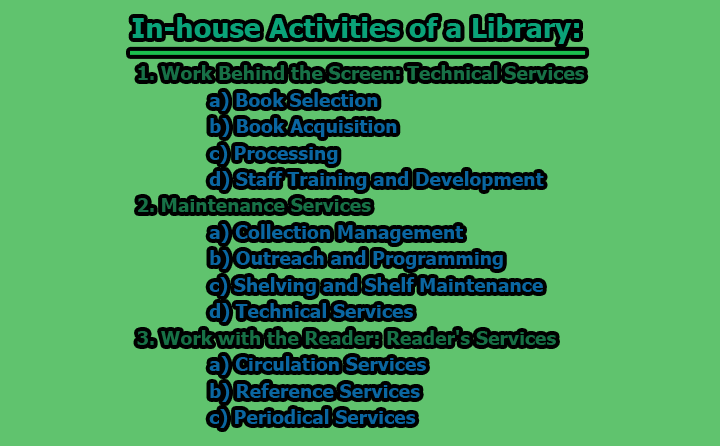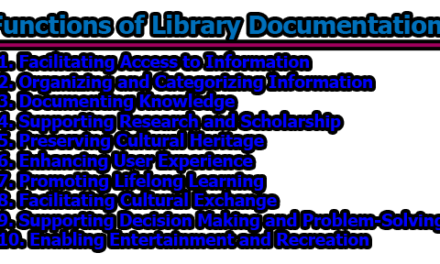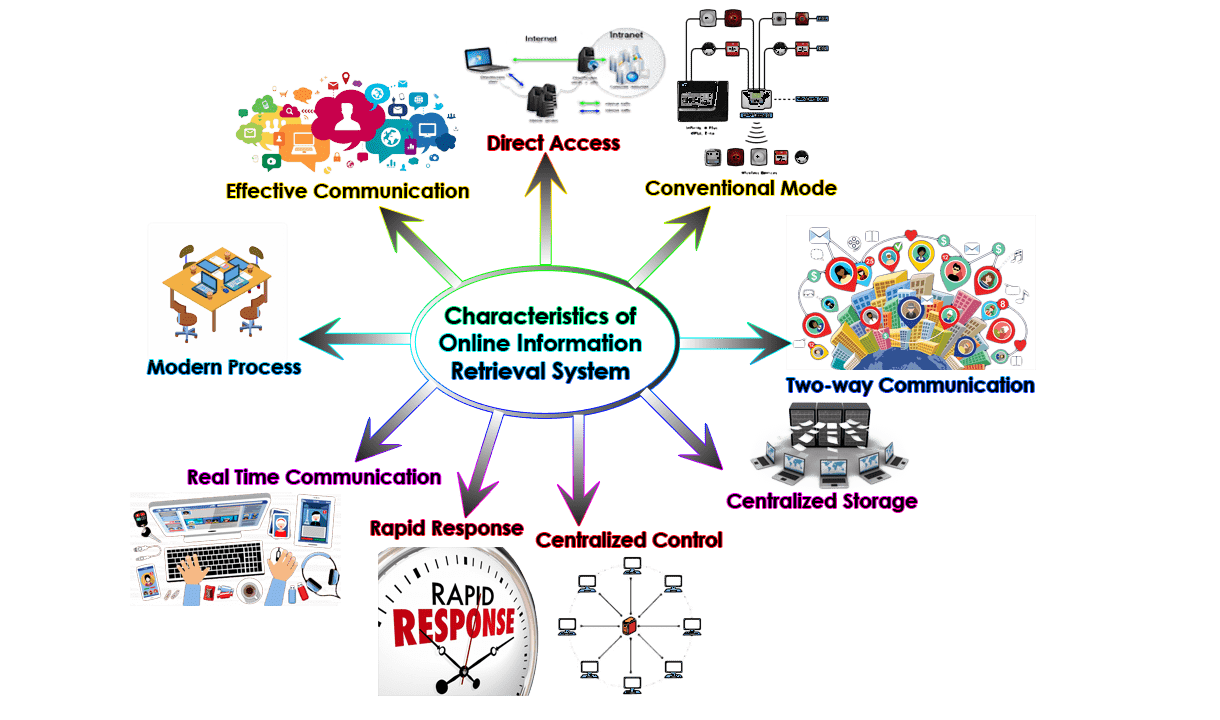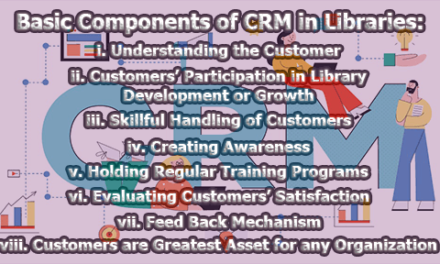In-house Activities of a Library: Ensuring Effective Resource Management and Patron Services
Libraries are vital institutions that serve as centers of knowledge, education, and community engagement. To fulfill their mission, libraries carry out various in-house activities that contribute to the efficient management of their resources and the provision of high-quality services to patrons. These in-house activities can be broadly categorized into two types: work behind the screen and work with the reader. Each type involves specific tasks and responsibilities performed by trained library staff members who collaborate to create a seamless experience for library users. In this article, we are going to know about the in-house activities of a library; ensuring effective resource management and patron services.
1. Work Behind the Screen: Technical Services: Technical services in a library are the backbone of its operations, encompassing essential behind-the-scenes activities that are crucial for acquiring, organizing, and making materials available to library patrons. These services play a vital role in ensuring that the library’s resources are efficiently managed and easily accessible to users. Technical services staff work diligently to maintain the integrity of the library’s collection and enable smooth navigation through its vast resources. Let’s explore the various aspects of technical services:
a) Book Selection: The process of book selection is a thoughtful and strategic task that involves curating the library’s collection to meet the diverse needs and interests of its users. Librarians, often in collaboration with subject specialists, carefully consider factors such as relevance, authority, and suitability when choosing materials. They strive to offer a well-rounded collection that provides information, entertainment, and knowledge across various genres, disciplines, and formats.
Book selection also requires staying attuned to current trends and emerging topics to ensure that the library remains up-to-date and relevant. In addition to considering user preferences, librarians may review usage statistics, conduct surveys, and analyze community needs to inform their selection decisions.
b) Book Acquisition: The acquisition of reading materials is a vital function of a library. Once the materials have been selected, the technical services team handles the acquisition process, which involves obtaining the selected items for inclusion in the library’s collection. The acquisition methods may include purchasing from vendors, publishers, or bookstores, as well as accepting donations from individuals or organizations.
Acquisition staff must carefully manage budgets and financial resources to optimize the purchasing power of the library. They work closely with vendors and negotiate favorable terms to ensure cost-effectiveness while obtaining high-quality materials.
In addition to purchasing, libraries may engage in exchange programs with other libraries, institutions, or consortia to enrich their collections through mutually beneficial agreements.
c) Processing: After the materials are selected and received, they go through the processing phase. This involves several important tasks to prepare the materials for use by library patrons:
- Cataloging: Catalogers assign descriptive data, subject headings, and classification numbers to each item, creating records that facilitate easy discovery and retrieval. Cataloging follows established standards such as MARC (Machine-Readable Cataloging) to ensure consistency and compatibility across libraries.
- Classification: Materials are organized and grouped according to subject categories using a classification system like Dewey Decimal Classification or Library of Congress Classification. This classification system helps users locate materials on similar topics in specific sections of the library.
- Labeling and Barcoding: Each item receives a unique label with a call number, enabling easy identification and shelving. Barcodes are also affixed to materials to facilitate circulation and automated tracking.
d) Staff Training and Development: Technical services staff members play a crucial role in ensuring the smooth functioning of the library’s operations. Continuous staff training and professional development are essential to keep them updated with the latest practices, technologies, and trends in the library field.
Training new library staff members helps them develop the necessary skills and knowledge to carry out technical services tasks effectively. Moreover, ongoing development programs for existing staff ensure they stay abreast of evolving practices, such as changes in cataloging rules or advancements in library management systems.
By investing in staff training and development, libraries can maintain a highly competent and efficient technical services team that contributes to the overall effectiveness of the library.
2. Maintenance Services: Maintenance Services in a library are essential for preserving the library’s collection, ensuring the physical upkeep of the facility, and providing a pleasant and functional environment for library patrons. The maintenance section plays a critical role in supporting the library’s mission to serve the community effectively. Let’s explore the various aspects of maintenance services in detail:
a) Collection Management: Collection management is a key responsibility of the maintenance section. This involves overseeing the proper shelving, storage, and display of library materials. Library staff working in this area ensure that books, periodicals, electronic resources, and other media types are organized and readily accessible to patrons.
Proper shelving is essential for facilitating easy browsing and retrieval of materials. Library staff employ classification systems and labeling techniques to ensure that books are arranged logically and consistently. They regularly inspect the shelves to re-shelve misplaced items and maintain the orderliness of the collection.
In addition to physical organization, collection management includes weeding and deselection activities. Library staff regularly assess the condition and relevance of materials in the collection, removing outdated, damaged, or seldom-used items to make way for new acquisitions.
b) Outreach and Programming: The maintenance section actively contributes to the library’s outreach efforts and programming initiatives. These activities aim to engage the community, attract new users, and foster a sense of belonging and connection with the library.
Outreach activities may include collaborating with local schools, community organizations, and other institutions to promote library services and resources. The maintenance team may also participate in community events, book fairs, and other gatherings to raise awareness about the library’s offerings.
Programming initiatives involve planning and organizing events, workshops, and activities that cater to the interests and needs of library patrons. The maintenance staff may be involved in setting up event spaces, arranging equipment, and ensuring that the facility is welcoming and suitable for different programs.
c) Shelving and Shelf Maintenance: A critical aspect of maintenance services is the proper shelving and maintenance of library materials. Library staff diligently shelve returned items in their designated places to ensure that the collection remains organized and easy to navigate for patrons.
Shelf maintenance involves routine inspections to identify damaged or worn-out shelves, bookends, or other shelving equipment. The maintenance team performs necessary repairs or replacements promptly to prevent accidents and to maintain a safe environment for library users.
Maintaining the aesthetics of the shelves and displays is also vital. Library staff regularly tidy and arrange books on the shelves to create an inviting and visually appealing browsing experience for patrons.
d) Technical Services: In addition to traditional maintenance tasks, the maintenance section may also be responsible for handling technical services related to library equipment and facilities.
This includes maintaining and troubleshooting library equipment, such as computers, printers, scanners, and photocopiers. The maintenance team ensures that these devices are in working order and promptly addresses any technical issues that arise.
Furthermore, the maintenance section plays a role in ensuring the physical upkeep and safety of the library building and its grounds. This includes routine maintenance and repairs, such as lighting fixtures, heating, ventilation, air conditioning systems, and other amenities, to create a comfortable environment for library users.
3. Work with the Reader: Reader’s Services: The reader’s service section of a library is a vital and dynamic component of its offerings to patrons. At the heart of this section are trained professionals who play a pivotal role in assisting library users in their quest for knowledge, information, and personal enrichment. Reader’s services focus on creating a welcoming and supportive environment that fosters a love for reading, learning, and exploration. Let’s delve into the various aspects of reader’s services in detail:
a) Circulation Services: Circulation services are at the forefront of reader’s services, and they form a crucial link between the library and its patrons. The circulation desk is often the first point of contact for visitors, making it a hub of activity. Trained staff members manage various circulation tasks, including:
- Check-ins and Check-outs: Circulation staff ensure that library materials are efficiently checked in when returned by patrons and promptly checked out when requested by users. This process involves managing due dates and issuing reminders for overdue items.
- Renewals: Readers often need additional time with materials they have borrowed. Circulation staff facilitate renewals, allowing patrons to extend the borrowing period if no other users have requested the same item.
- Holds and Reservations: When a desired item is unavailable, readers can place holds or reservations. Circulation services manage these requests, ensuring that patrons are notified when the item becomes available.
- Library Card Services: Circulation staff help users apply for library cards, which grant them access to the library’s resources and services. They also assist with updating user information and managing accounts.
- Fines and Fee Management: While libraries aim to be accommodating, certain rules are necessary for the fair use of resources. Circulation staff handle fines and fee management for overdue or damaged materials.
b) Reference Services: Reference services are a cornerstone of the reader’s service section. Librarians and reference specialists possess extensive knowledge and expertise, enabling them to assist patrons with their information needs effectively. Key aspects of reference services include:
- Information Retrieval: Reference librarians excel at finding accurate and reliable information for patrons. They help users navigate through the vast collection of resources, including books, databases, and online materials.
- Research Assistance: When patrons require assistance with academic or personal research projects, reference staff offer guidance in formulating research questions, locating appropriate sources, and evaluating information credibility.
- In-depth Queries: Reference librarians are skilled at handling complex and specific queries, such as historical research, legal inquiries, or scientific investigations. They utilize their expertise and access to specialized databases to provide comprehensive answers.
- Readers’ Advisory: An essential part of reference services is readers’ advisory, wherein librarians recommend books, articles, and other materials based on individual preferences and interests. This personalized approach enhances the reading experience for users.
- Special Collections: Libraries may have rare or specialized collections that require expert assistance. Reference staff curate and manage access to these collections, supporting researchers and scholars in their studies.
c) Periodical Services: Periodical services in the reader’s service section are responsible for providing access to newspapers, magazines, and other periodicals. This involves:
- Subscription Management: Library staff maintains a diverse collection of periodicals by managing subscriptions, renewals, and cancellations based on user preferences and interests.
- Display and Access: Periodical materials are displayed in a way that is visually appealing and accessible to patrons. This encourages browsing and discovery of new topics and subjects.
- Online Periodicals: In today’s digital age, libraries often offer online databases and e-journals. Periodical services provide guidance on accessing and navigating these resources, ensuring users can access the latest information from various publications.
- Current Awareness: Library staff may curate lists of articles on specific topics or create current awareness services to keep patrons informed about recent developments in their areas of interest.
From the above discussion, we can say that in-house activities are the lifeblood of a library, ensuring that resources are effectively managed and library users receive top-notch services. Behind-the-scenes technical services and maintenance efforts work hand in hand to provide a well-organized and accessible collection, while reader services focus on assisting patrons in their quests for knowledge and information. The dedication and expertise of trained library staff make libraries invaluable community resources, fostering education, supporting research, and enriching lives through the power of information and learning. As libraries continue to evolve and adapt to the changing needs of their users, these in-house activities will remain essential in preserving their role as cherished pillars of knowledge and culture in any community.
Frequently Asked Questions [FAQs]:
What are the in-house activities of a library?
In-house activities of a library refer to the various tasks and functions carried out within the library premises to manage its resources, services, and operations. These activities include collection management, cataloging, circulation services, reference services, staff training, and technical services.
What is the role of technical services in a library?
Technical services in a library are responsible for acquiring, organizing, and making materials available to patrons. This includes tasks such as book selection, book acquisition, cataloging, and classification, as well as managing electronic resources and troubleshooting technical issues.
How does the maintenance section of a library contribute to its effective functioning?
The maintenance section of a library plays a crucial role in preserving the library’s collection, ensuring proper shelving and shelf maintenance, and maintaining a clean and well-organized environment for patrons. They also handle technical services related to library equipment and facilities, ensuring a safe and functional library space.
What is the purpose of outreach and programming in a library?
Outreach and programming activities in a library are designed to engage the community and attract new users. These initiatives promote the library’s services, resources, and events, fostering a sense of community and encouraging lifelong learning among patrons.
How do reader services assist library patrons?
Reader’s services provide personalized assistance to library users in locating, selecting, and obtaining materials of interest. Reference librarians offer research guidance, readers’ advisory, and access to specialized collections, ensuring users make the most of the library’s resources.
What is the significance of collection management in a library?
Collection management ensures that the library’s resources align with the needs and interests of its users. Librarians regularly evaluate the collection, remove outdated materials, and strategically add new acquisitions to keep the collection relevant and valuable to patrons.
How can library staff benefit from staff training and development?
Staff training and development help library staff stay informed about industry developments and trends, enhancing their skills and expertise. Continuous training enables staff to provide high-quality services and adapt to changing user needs effectively.
What are some common circulation services offered by libraries?
Circulation services involve activities such as checking materials in and out of the library, managing due dates and renewals, processing holds and reservations, and issuing library cards. The circulation desk serves as the primary point of contact between the library and its users.
How do periodical services keep patrons informed?
Periodical services provide access to newspapers, magazines, and other publications. Libraries manage subscriptions, organize and display periodicals, and offer access to online databases, enabling patrons to stay updated with the latest news and research in their areas of interest.
How can patrons benefit from reference services in a library?
Reference services help patrons find information, conduct research, and navigate library resources effectively. Reference librarians provide expertise and assistance in various subjects, supporting patrons in their educational and professional endeavors.
References:
- Smith, J. (2018). The Role of Technical Services in Modern Libraries. Library Management, 39(2), 112-126.
- Johnson, M. A. (2020). Collection Management Strategies: Enhancing Library Resources for Diverse User Needs. Information Services Journal, 25(3), 189-201.
- Williams, S. L., & Martinez, R. (2019). Engaging the Community through Library Outreach and Programming. Public Libraries Today, 12(4), 245-260.
- Taylor, R. K. (2017). Shelving and Shelf Maintenance Best Practices for Efficient Library Services. Journal of Library Administration, 42(1), 57-71.
- Brown, L. M., & Clark, A. B. (2018). Reader’s Advisory Services: A Comprehensive Guide to Assisting Library Users. Library Quarterly, 37(4), 315-329.

Assistant Teacher at Zinzira Pir Mohammad Pilot School and College










